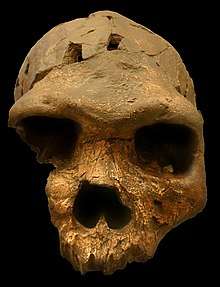Bodo cranium
The Bodo cranium[1] is a fossil of an extinct type of hominin species. It was found by members of an expedition led by Jon Kalb in 1976.[2] The Rift Valley Research Mission conducted a number of surveys that lead to the findings of Acheulean tools and animal fossils, as well as the Bodo Cranium.[3] The initial discovery was by Alemayhew Asfaw and Charles Smart, who found a lower face. Two weeks later, Paul Whitehead and Craig Wood found the upper portion of the face. Pieces of the cranium were discovered along the surface of one of the dry branches of the Awash River in Ethiopia.[1] The cranium, artifacts, and other animal fossils were found over a relatively large area of medium sand, and only a few of the tools were found near the cranium.[4][5] The skull is 600,000 years old[6] and is classified as Homo heidelbergensis (Homo rhodesiensis).[7]
 Bodo cranium, Smithsonian Natural History Museum | |
| Common name | Bodo |
|---|---|
| Species | Homo heidelbergensis (Homo rhodesiensis) or Homo erectus(?) |
| Age | 600,000 years |
| Place discovered | Bodo D'ar, Awash River valley of Ethiopia |
| Date discovered | 1976 |
| Discovered by | Asfaw, Smart |
Observation
This specimen has an unusually large cranial capacity for its age that is estimated at around 1250 cc (in the range between ∼1,200–1,325 cc) within the (lower) range of modern Homo sapiens.[8] The cranium includes the face, much of the frontal bone, parts of the midvault and the base anterior to the foramen magnum. The cranial length, width and height are 21 cm (8.3 in), 15.87 cm (6.2 in) and 19.05 cm (7.5 in) respectively. Researchers have suggested that Bodo butchered animals because Acheulean hand axes and cleavers, along with animal bones, were found at the site. Cuts on the Bodo cranium show the earliest evidence of removal of flesh immediately after the death of an individual using a stone tool.[4] The findings of symmetrical cut marks with specific patterns and directionality on the cranium serve as strong evidence that de-fleshing was done purposefully for mortuary practices and represents the earliest evidence of non-utilitarian mortuary practices.[4][9] The cut marks were located “laterally among the maxilla” causing speculation among researchers that the specific reason for de-fleshing was to remove the mandible.[10]
Evolutionary Significance
The cranium has an unusual appearance, which has led to debates over its taxonomy. It displays both primitive and derived features, such as a cranial capacity more similar to modern humans and a projecting supraorbital torus more like Homo erectus.[1][11][12] Bodo and other Mid-Pleistocene hominin fossils appear to represent a lineage between Homo erectus and anatomically modern humans, although its exact location in the human evolutionary tree is still uncertain.[13][14] The increased encephalization seen in fossils like the Bodo cranium is thought to have been a driving force in the speciation of anatomically modern humans.[15][16]
References
- Rightmire, Philip G. (1996-07-01). "The human cranium from Bodo, Ethiopia: evidence for speciation in the Middle Pleistocene?". Journal of Human Evolution. 31 (1): 21–39. doi:10.1006/jhev.1996.0046. ISSN 0047-2484.
- "Bodo Skull and Jaw". Skulls Unlimited. Archived from the original on 2015-12-08. Retrieved 15 October 2012.
- Conroy, Glenn C.; Weber, Gerhard W.; Seidler, Horst; Recheis, Wolfgang; Zur Nedden, Dieter; Haile Mariam, Jara (2000). "UC Berkeley Library Proxy Login". American Journal of Physical Anthropology. 113: 111–118. doi:10.1002/1096-8644(200009)113:1<111::aid-ajpa10>3.0.co;2-x.
- White, Tim D. (April 1986). "Cut marks on the Bodo cranium: A case of prehistoric defleshing". American Journal of Physical Anthropology. 69 (4): 503–509. doi:10.1002/ajpa.1330690410. ISSN 0002-9483. PMID 3087212.
- Kalb, Jon E.; Wood, Craig B.; Smart, Charles; Oswald, Elizabeth B.; Mabrete, Assefa; Tebedge, Sleshi; Whitehead, Paul (1980-01-01). "Preliminary geology and palaeontology of the Bodo D'ar hominid Site, Afar, Ethiopia". Palaeogeography, Palaeoclimatology, Palaeoecology. 30: 107–120. doi:10.1016/0031-0182(80)90052-8. ISSN 0031-0182.
- "Bodo". Humanorigins.si.edu. Retrieved 15 October 2012.
- "Bodo fossil". Britannica Encyclopedia. Retrieved 15 October 2012.
- Milner, Richard. "Cranial Capacity." The Encyclopedia of Evolution: Humanity's Search For Its Origins. New York: Holt, 1990: 98. "Living humans have a cranial capacity ranging from about 950 cc to 1800 cc, with the average about 1400 cc."
- Tarlow, Sarah; Stutz, Liv Nilsson (2013-06-06). The Oxford Handbook of the Archaeology of Death and Burial. OUP Oxford. ISBN 9780199569069.
- Pickering, Travis Rayne; White, Tim D.; Toth, Nicholas (2000). "Brief communication: Cutmarks on a Plio-Pleistocene hominid from Sterkfontein, South Africa". American Journal of Physical Anthropology. 111 (4): 579–584. doi:10.1002/(sici)1096-8644(200004)111:4<579::aid-ajpa12>3.0.co;2-y. ISSN 1096-8644. PMID 10727975.
- Rightmire, G. Philip (2001-01-01). "Patterns of hominid evolution and dispersal in the Middle Pleistocene". Quaternary International. 75 (1): 77–84. doi:10.1016/S1040-6182(00)00079-3. ISSN 1040-6182.
- Bräuer, Günter (2008). "The origin of modern anatomy: By speciation or intraspecific evolution?". Evolutionary Anthropology: Issues, News, and Reviews. 17 (1): 22–37. doi:10.1002/evan.20157. ISSN 1520-6505.
- Rightmire, G. Philip (2013-09-01). "Homo erectus and Middle Pleistocene hominins: Brain size, skull form, and species recognition". Journal of Human Evolution. 65 (3): 223–252. doi:10.1016/j.jhevol.2013.04.008. ISSN 0047-2484. PMID 23850294.
- Krovitz, Gail; McBratney, Brandeis M.; Lieberman, Daniel E. (2002-02-05). "The evolution and development of cranial form in Homo sapiens". Proceedings of the National Academy of Sciences. 99 (3): 1134–1139. doi:10.1073/pnas.022440799. ISSN 0027-8424. PMC 122156. PMID 11805284.
- Rightmire, G. Philip (January 2012). "The evolution of cranial form in mid-Pleistocene Homo". South African Journal of Science. 108 (3–4): 68–77. doi:10.4102/sajs.v108i3/4.719. ISSN 0038-2353.
- Conroy, Glenn C.; Weber, Gerhard W.; Seidler, Horst; Recheis, Wolfgang; Nedden, Dieter Zur; Mariam, Jara Haile (2000). "Endocranial capacity of the Bodo cranium determined from three-dimensional computed tomography". American Journal of Physical Anthropology. 113 (1): 111–118. doi:10.1002/1096-8644(200009)113:1<111::aid-ajpa10>3.0.co;2-x. ISSN 1096-8644. PMID 10954624.